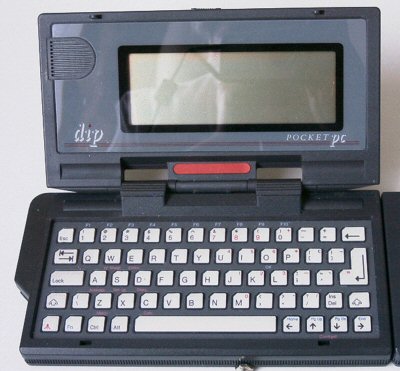DOS Palmtop: DIP Pocket PC Details and specs
DIP Pocket PC (DIP Pocket Personal Computer)

About this machine:
A true legend, but probably not as true as you think it is. Yes the DIP Pocket PC definitely IS the first AA-Battery powered IBM compatible
Computer ever, no doubts. But the question is "Did it ever go in production" as this before it was marketed as the "Atari Portfolio" by Atari?
I have doubts. As all DIP Pocket PC i have ever seen had the "Atari key", so it is highly questionable if there was ever an "Atari indipendant" version
produced. The legend says that "A few month after DIP released the pocket PC Atari has bought the rights to license it as the Portfolio while
DIP kept releasing it as the DIP Pocket PC in the UK.". Well i think the later part might be true. But the lack of proof for any DIP Pocket
PC without the "Atari Key" makes me think it never made it out of prototype state before Atari signed the "We market it as the portfolio" deal.
However let's start with the beginning - DIP was founded by David Frodsham, Ian Cullimore and Peter Baldwin. If you take the initials of their
first names you can see where the name "DIP" came from. Officially of course "Distributed Information Processing" Systems. Cullimore had
actually worked on Psions first organizer which was released in 1984. In 1985 Cullimore was the original founder of "pocket pc" which resulted
in the "DIP pocket pc" in 1989. Whether any DIP pocket PCs have been produced without Atari or not - the first Atari Portfolio was showcased in
April 1989. Ironically in september 1989 - five month after Atari introduced the portfolio - the Poquet PC was introduced - a fully CGA compatible
8088 with MS-DOS 3.3 started shipping. Cullimore was a co-founder of "Poqet Computer Corporation", the company that produced the poqet pc.
ullimore was also one of the creators of the PCMCIA standard which was included in the Poqet PC but not the DIP/Portfolio Pocket PC. The
Atari portfolio is still a cult machine as the first palmtop PC ever available to the public, but like the HP 95LX it suffers from the MDA graphics
mode which is barely compatible to any DOS application. However, due to the large support of the community there are hundreds of applications
available for the portfolio as well as numerous hacks.
Specs:
CPU: 80C88, running @ 4.9152 MHz
Graphics: Text mode, 40 characters x 8 lines
Display: 240 x 64 monochrome STN , 2 scales
Memory (RAM): 128 KB or 256 KB (The later models featured 256 KB)
ROM (Software): 256 KB
I/O ports: Expansion port, Memory card expansion slot
Sound: PC Speaker - Piezo
Operating System: DIP DOS 2.11
Software: Text editor, spreadsheet (Lotus 1-2-3 compatible), phone book and time manager.
Size: Length 8.5cm, Width 15.9cm, Height 2.6cm (3.4 inches x 6.3 inches x 1 inch)
Powered by: 3 AA batteries or AC adaptor (optional accessory), CR2032 Lithium button cell as memory backup
Weight: 505 gram (18 ounces)
Special features: Parallel, serial, modem and midi modules available for expansion slot.
Released: (before?) April 1989
Originally retailed for:: 399.95 USD (Atari Portfolio)
Clone of: Not a clone
Similar models: Atari Portfolio, Atari PC Folio, HP 95LX
Pros:
- Contains Lotus 1-2-3 compatible spreadsheet and word processor
- Fair Battery life
Cons:
- Due to graphics mode barely compatible with any standard DOS application
- Can only use proprietary Atari Memory cards (Also used by some Korg Synthezizers)
- Keyboard extremely small, not comfortable for really typing a lot
- Low RAM, proprietary DOS, proprietary PIM applications
- Probably expensive as rather rare compared to portfolios
Collector Value:
9 of 10
Usage Value:
3 of 10
Verdict:
If the standard software on the ROM suits your needs you can give it a usability value of 7/10 (8/10 if you love the tiny keyboard).
This is definitely a collectable. However the few DIP Pocket PC around are all 100% the same as the normal Atari Portfolio so besides
a case with high collector value you get a standard portfolio. If you want to get any use of it you are better off with a normal portfolio
which is available for about the value of a good pizza on ebay. Leave the dip to the hardcore collectors.
Back to the Palmtop PC index
